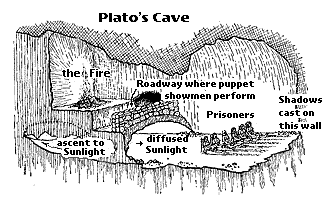Examples and Exemplification
Plato's Cave

A «category» is an idea, so you can know it but you cannot observe it in the conventional sense. It is therefore Platonic![]() in nature. You can only observe examples of categories. So, once a THEE framework is accepted, observational certainty is often possible e.g. outsiders can know whether or not a particular form of purpose (like a priority) has been specified in a planning document.
in nature. You can only observe examples of categories. So, once a THEE framework is accepted, observational certainty is often possible e.g. outsiders can know whether or not a particular form of purpose (like a priority) has been specified in a planning document.
As in that example, a THEE entity is a psychosocial category that has a name assigned. However, psychosocial categories or their names must be used in an external world that is intrinsically messy or impure (scientifically).
Any assumed or believed observation of a particular entity-category is best thought of as an «example» or «exemplification» of the entity. So it is an epistemological error to make brute observation of psychosocial phenomena, and expect precision from such studies. They cannot capture the deeper nature of THEE entities: reality is too messy.
Reality is Messy
In the arena of human experience and social phenomena, reality is just too complex for brute empiricism. Any person involved in committed action activates various disparate THEE entities. Some are obvious and others are difficult to perceive.
Recording and analysis of many instances (i.e. examples) can serious mislead because:
- Entities are defined by function which depends on a person’s intentions, responsibilities and freedom.
- Multiple frames of reference exist simultaneously and the same example may reflect THEE entities at several levels and in different domains.
- Any social situation may contain actors not fully engaged and genuinely committed.
- Many people misuse entities &/or names, either deliberately (like advertisers and politicians), or from ignorance and habit, or because precision is unnecessary.
Q: When social science investigators study «compromise», do they study all forms of compromise—e.g. between parent and child, between antagonistic organizations, in a legal setting, when buyers and sellers bargain, within a strategic alliance, between two governments, in a consortium of nations, within a family, & between neighbours?
A: Rarely. Scientific researchers have good practical and personal excuses like:
- lack of resources for such a broad study
- access to families or international negotiations is difficult
- sponsors and funders for the study are not supportive
- lack of specific interest in the whole psychosocial field
- absence of any career incentives to work so broadly.
Nevertheless, we can be quite certain that compromise-generating activities in disparate contexts will show many differences in the details. The only way to get at the deep nature of «compromising» from an empirical approach would be to examine a wide variety of situations, so that only what is common to all remains.
The sheer number of perspectives and practical factors—personalities, local culture, resources, political pressures, physical problems, dynamic environments, and more—make it impossible to separate truly relevant data on the human element from coincidental data.
As a result, theories based on empirical or explanatory methods are highly likely to include misleading contextual features and inappropriate assumptions.
The Taxonomy Precedes Examples
Examples are tricky. Looking at data alone will never reveal the Taxonomy. Conventional scientific observational methods find psychosocial realities far too complicated and open. Shadows are measured as a substitute for the real thing: see graphic above right.
The reverse, however, is quite possible. If the THEE-entity is well-formulated and validated and its properties are well-known, then it is not too difficult to find examples in the world. Sensible research of a conventional sort can then be carried out. Such research has occurred in regard to systems of and
- Processes by which categories emerge within the taxonomic architecture.
Originally posted: August 2009; Last updated 2-Feb-2014.